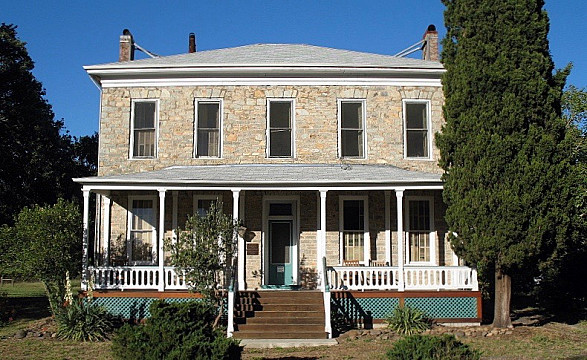Glen Oaks Ranch
13255 Sonoma Highway, Glen Ellen, California
Built in 1870, for Colonel Charles Vaincoeur Stuart (1819-1880) and his “refined and cultured” wife, Mary Ellen Tourtellot, for whom the district of Glen Ellen is named. Stuart had already erected the first brick house in San Francisco at 16th and Capp before establishing himself as a pioneer viticulturalist in the Valley of the Moon. In 2001, this house and its 234-acre ranch that neighbours the historic Beltane Ranch was donated to the Sonoma Land Trust: Its “valley oaks are among the finest stands in the Sonoma Valley and provide a stunning reminder of early California”.

Glen Ellen in the Sonoma Valley was once grazing land used by the Wappo Indians before being absorbed into the 18,833-acre Rancho Los Guilicos. In 1837, the ranch was granted by Governor Juan Bautista Valentin Alvarado (1809-1882) to Captain John Downes Wilson (1798-1861) and his wife, Dona Maria Ramona Carrillo de Pacheco (1812-1888), sister-in-law of General Mariano Guadalupe Vallejo (1807-1890). The Wilsons never lived there and in 1859 they sold off a 1,000-acre tract to Charles Stuart.
Stuart was a New Yorker who came to California in the Gold Rush of 1849. Having secured his fortune in San Francisco real estate, he purchased the 1,000-acres and planted new vineyards there, naming his wine estate Glen Ellen, for his wife.
Stuart was a New Yorker who came to California in the Gold Rush of 1849. Having secured his fortune in San Francisco real estate, he purchased the 1,000-acres and planted new vineyards there, naming his wine estate Glen Ellen, for his wife.
In 1872, he renamed his home Glen Oaks to avoid confusion with the village of Glen Ellen – which had taken the same name as his estate - that had since grown up around them. Stuart had employed Chinese workers to build his comfortable house and is remembered as the only delegate of the California Constitutional Convention of 1878-79 to speak out passionately in defense of the rights of Chinese Immigrants.
Stuart died in 1880, when his wife and son, Charles Duff Stuart, took over the running of the Glen Oaks and Mrs Stuart became a well-known wine maker in her own right. But by the late 1890s, the vineyard was no longer being attended to as it once had.
In 1896, Mary Ellen Stuart sold Glen Oaks to Frederick Quien (1844-1917) and his wife, Elizabeth Irvine (1850-c.1935). Fred was a native of France who became a partner in the firm of Clark, Quien & Morse, “one of the largest hardware wholesale houses in Central Illinois” with goods sold across the States. But on acquiring Glen Oaks he sold out of his partnership and happily became a farmer.
The Quiens pulled out the phylloxera-infested vines and planted plum trees. They raised hay, grazed horses, kept chickens and grew peaches, apples and plums.
Times must have swiftly turned tough as within ten years of living at Glen Oaks the Quiens were advertising their home as an inn, describing it as, “a quiet peaceful place (with) large, airy rooms” near a “romantic canyon” and capable of accommodating 20 guests. But, clearly their prospects did not improve and in 1912 they sold Glen Oaks to James R. Burnham and moved to Napa.
James Burnham was a native of Iowa who'd settled at Oakland in California. In 1917, Glen Oaks was listed in the Social Register as the summer home of James’ daughter, Lucretia Burnham (1882-1955), and her husband, Charles David Bates (1872-1945).
In 1952, Glen Oaks was acquired by the charismatic advertising executive Roswell Cochran and his wife Camille Martin, the adopted stepdaughter of Howard Middleton (d.1943) President of the Goodyear Rubber Company, of San Francisco. Camille also happened to be a descendant of the first school teacher in San Francisco, Manuel Boronda (1750-1826), of Monteroy.
In 2001, their daughter Joan Cochrane bequeathed the 234-acre property to the Sonoma Land Trust. The rounds are now parkland open tot he public and the house is also a public building. The Knobe grand piano that was shipped around Cape Horn by the Stuarts back in the 1880s and has remained at Glen Oaks ever since and can still be seen in the front room today.
Categories
Styles
Share
http://baselineconsult.com/wp-content/uploads/2011/12/Quien_GlenOaks_lowres.pdf
https://localwiki.org/oakland/Charles_and_Lucretia_Bates_House
Connections
Be the first to connect to this house. Connect to record your link to this house. or just to show you love it! Connect to Glen Oaks Ranch →
